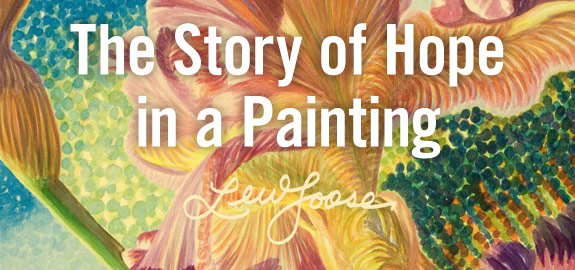Judy LewLoose is an artist who uses pointillism to capture the light, spirit, and possibilities of hope in one image. Through these artistic conversations, she offers perspectives of individuals experiencing homelessness that people might not otherwise be able to see.

Judy LewLoose is a graphic designer, painter, and mother of two. A graduate of the Pratt Institute in New York, she works as a graphic designer during the day. She also paints every single night after she puts her children to bed. She infuses hope, life, and light into all of her portraits. Her photographs and paintings reveal previously untold stories.
“It was like a box,” Ms. LewLoose says, describing her own first apartment. She slept on a floor crawling with rats and cockroaches for 2 years. She observed many people experiencing homelessness in the alley outside her window. It struck her that she was a struggling artist and they were struggling people. From there, she moved into another box-like apartment in New Jersey, lost her mother, became ill, and went through a divorce. She began to wonder what she could paint—outside those boxes—that would make a difference in the world.
After the media exposed the tent cities in Sacramento, California, Ms. LewLoose wandered down to the camps. The humanity there amazed her, “There was a woman named Kate (not her real name) with auburn hair. She told me her story of 30 years. What I noticed most at first were the lines on her face. Her face told a visual story. I asked her if she would mind if I painted her. She said, ‘Wait right here, I am going to brush my hair.’”
Ms. LewLoose mistakenly assumed that people living on the street would not brush their hair. She prepared to take a photograph of Kate. Her style of painting—pointillism—takes up to 40 hours to complete so photographs are the models she uses back at the studio.
When Kate returned after combing her hair, she asked, “If you paint me, I would be honored to have it as a wedding present.” Ms. LewLoose fulfilled the request and that first painting began a series of portraits of people experiencing homelessness.
She also discovered many people were angry and bitter because they had to leave their makeshift homes. She encountered a man—whose portrait title is Sheltering Eyes—working on his bike. She photographed his bike and he asked if she was from the media. Rolling her eyes, she said, “Yeah, right.” At that point, he asked her to paint him. She explained that she needed to have a connection first. They began to talk. He told her that he spent the last 30 years jumping from train to train and did not like the life. He wore dark glasses and had no teeth. She took some photographs, but she just could not “read” him. When he took off his sunglasses, she says, “He had the most striking, beautiful eyes I had ever seen.” His image became a painting.
Following the Sacramento series, Ms. LewLoose spent time in shelters for women and children. She observed that children look up to their mothers no matter where they are. She found that many of the women came from domestic violence backgrounds. They were initially reluctant to allow photography and were extremely protective of their children. She also notes, “These women were incredibly ambitious to get out of the shelter. One woman said to me, ‘When we get out, I want you to paint our picture and put it in my home.’”
In California, the Sierra Health Foundation was the first group to hang her work, followed by Trinity Episcopal Cathedral, and then another church in Auburn. “People would bring food in bags and leave them underneath the paintings,” said Ms. LewLoose. Her goal is to raise awareness of people in need of help.
